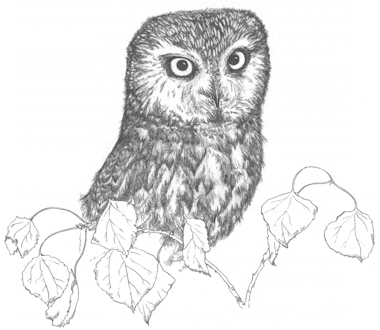Northern Saw-whet Owl
Aegolius acadicus
Nineteenth century naturalists sometimes caught these owls with their bare hands. Apparently, saw-whets are so small and so cryptically colored that their usual reaction to predators is to remain perfectly still.
Northern saw-whet owls nest throughout much of North America, from deciduous forests in New England to aspen and lodgepole pine forests in the Cascades and Rockies. In Boulder County they favor aspen groves and open coniferous forests between 6,000 and 10,000 feet.
Vocal activity generally begins in March, continues through May, and may resume for a brief period in the fall. Saw-whets respond readily to tape playbacks of their territorial call. The female lays four to seven eggs in a woodpecker hole in April or May. Young fledge in June or July. Most individuals migrate south in September or October.
During the day saw-whets perch motionless on a conifer, aspen, or box elder branch. At night they hunt mice, voles, and other small mammals in meadows and forest clearings. Local populations may fluctuate from year to year in response to variations in prey populations.

Vocalizations: High, hollow whistles, 1-2 per second, slightly higher pitched than northern pygmy-owl; a rising rasp, like someone sharpening a saw with a whet-stone; soft hoots, mews, and squeals.
Nesting: April-July in aspen groves, open, for forests, and, rarely, riparian woodlands, 5,000 to 10,000 feet.
Where to listen and look: Enchanted Mesa and Green Mountain West Ridge in the Boulder Mountain Park; South St. Vrain Canyon; Peak to Peak Highway.
